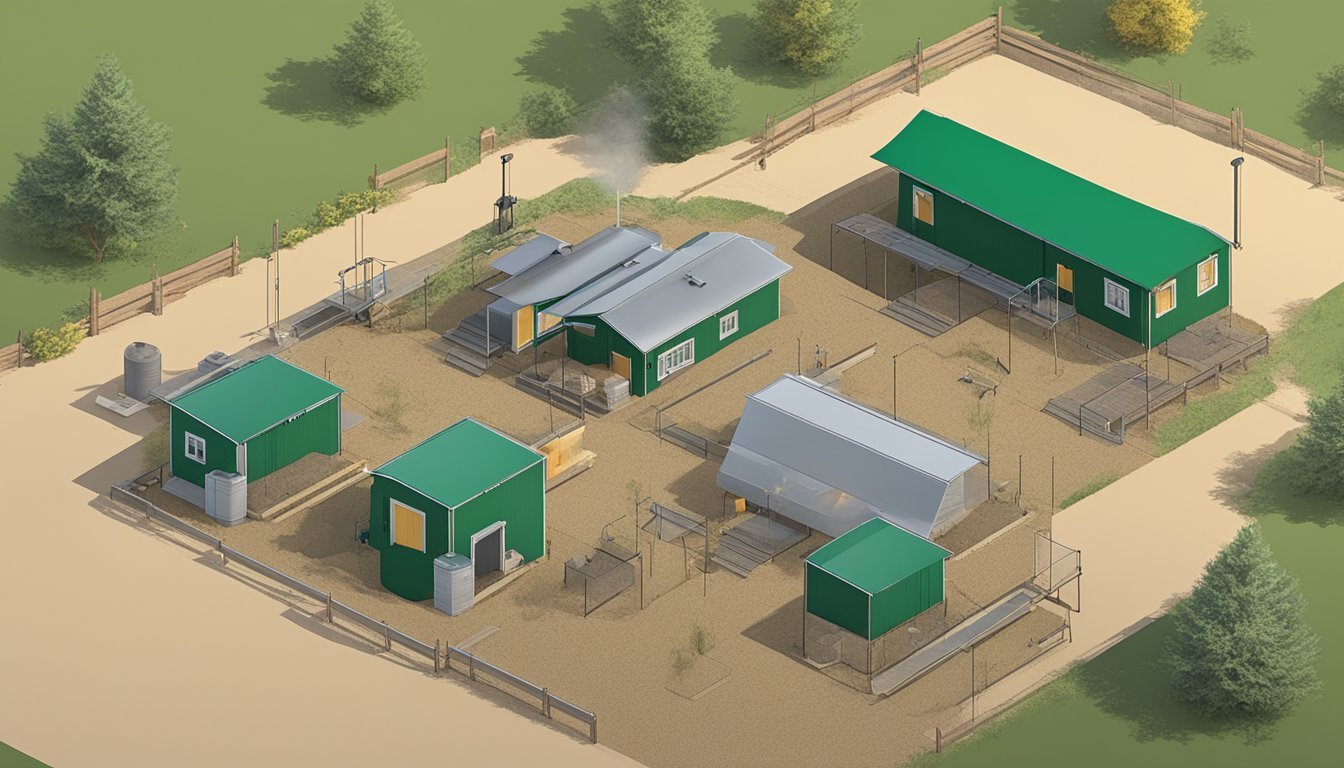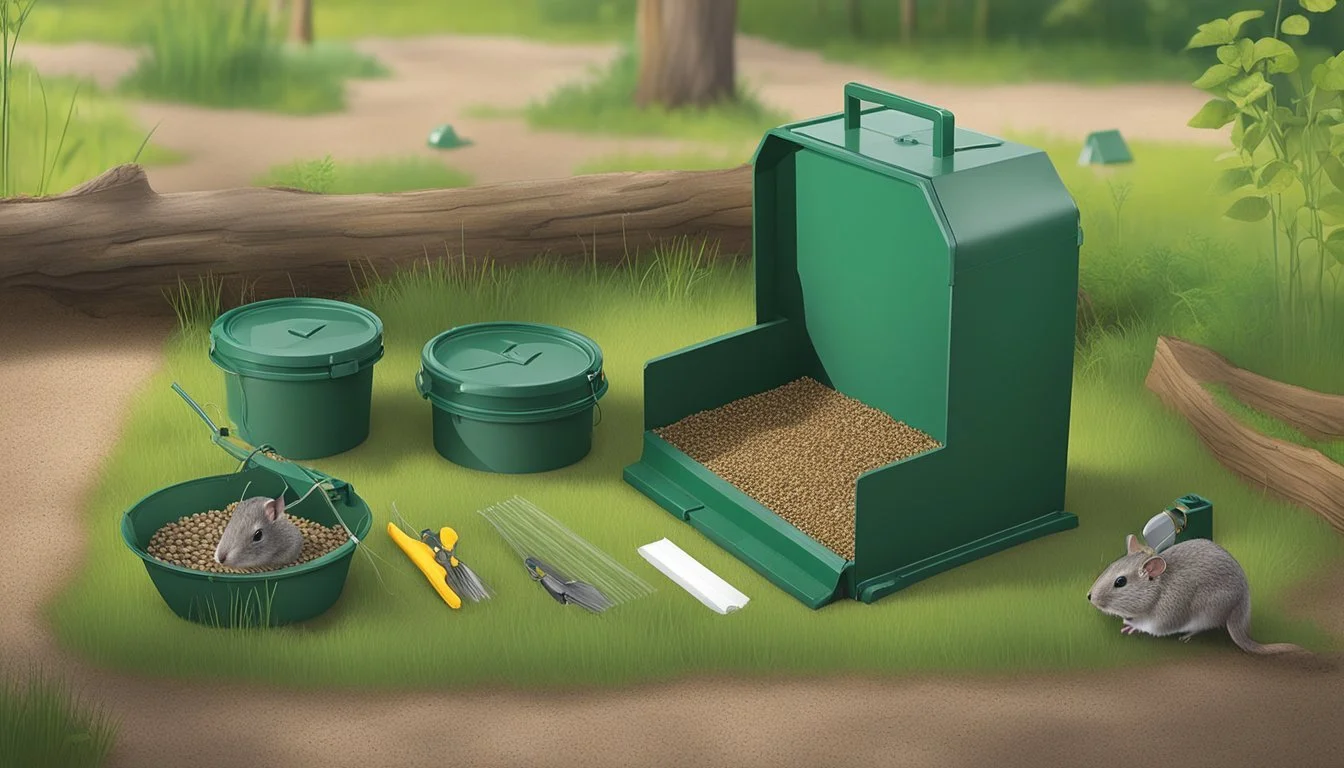The Ultimate Guide to Rodent Bait Stations
Mastering Rodent Control in Homesteading
To effectively manage a rodent population on a homestead, one must approach the issue with practical solutions and an understanding of the available control methods. Rodent bait stations have become a preferred choice for many who seek to reduce the unwanted guests without adversely impacting the surrounding environment. These devices are specifically designed to entice rodents into an enclosed area where bait or poison awaits them, thereby limiting exposure to non-target animals and children. The contained nature of bait stations also adds an element of safety and cleanliness, not found with traditional snap traps or open baiting methods.
Choosing the correct number and placement of rodent bait stations is critical to their success. For an average-sized residential property, it is generally advised to place bait stations approximately 10 to 30 feet apart, depending on the extent of the rodent problem. Placement should be strategic, as rodents typically move along the perimeter of a property or building. Regular monitoring and maintenance of these stations is equally important to continuously assess their effectiveness and to replenish the bait as needed, ensuring ongoing control of the rodent population.
The optimization of bait station efficiency is a key facet of rodent management. Pest professionals recommend a more dense distribution of stations in the presence of a severe infestation. As rodents have different habits and preferences, it's also essential to adjust the spacing and baiting strategy according to the specific rodent species being targeted. Mice, for example, might require bait stations placed closer together compared to those for rats. Understanding and responding to these nuances can make the difference in achieving a rodent-free homestead.
Understanding Rodent Behavior and Risks
Successful rodent control on a homestead begins with a deep understanding of the behavior of common rodent species and recognizing the potential risks they pose. Establishing effective bait stations requires insight into where and why rodents are infesting an area.
Identifying Common Rodent Species
Mice (Mus musculus) and rats (Rattus norvegicus and Rattus rattus) are the most prevalent rodent species that invade homes. House mice are small, agile creatures, usually light brown to gray, with an average length of 3-4 inches excluding the tail. Norway rats and roof rats are larger, ranging from 7-10 inches in length, with roof rats being slender and Norway rats more robust. These rodents are known for their constant gnawing due to their continuously growing incisor teeth.
Health Risks Associated with Rodent Infestations
Rodent infestations carry significant health risks due to the diseases they can spread, like hantavirus, leptospirosis, rat-bite fever, and salmonellosis. Their droppings, urine, and saliva can contaminate food sources and household surfaces. Additionally, they are capable of causing severe damage to property, chewing through wiring and insulation, which can create fire hazards.
Disease: Hantavirus
Transmission Method: Inhalation of dust contaminated with droppings or urine
Symptoms: Fever, muscle aches, coughing
Disease: Leptospirosis
Transmission Method: Contact with water contaminated by urine
Symptoms: Headaches, muscle aches, fevers
Disease: Rat-bite fever
Transmission Method: Bites or scratches, handling rodents
Symptoms: Fever, rash, arthralgia
Signs of a Rodent Problem in Your Homestead
One can identify a rodent problem through physical evidence of their presence. This includes droppings, which are pellet-shaped and dark in color, typically found along walls or in places where food is stored. Gnaw marks on food packaging or structures, a distinctive odor of urine, or the sounds of scurrying in walls and attics, particularly at night, are indicative of an infestation. Another indicator is nervous system damage in livestock or pets, which can result from diseases transmitted by rodents.
Principles of Rodent Control
Effective rodent control is a multi-faceted approach that requires a combination of strategic planning, vigilance, and targeted action to manage and prevent rodent populations from impacting homesteading activities.
Integrated Pest Management (IPM) Approach
Integrated Pest Management (IPM) is a holistic strategy which involves using a variety of practices to solve pest problems while minimizing risks to people and the environment. For rodent control, IPM means combining the use of rodent baits and traps with habitat modifications. IPM emphasizes the use of least toxic methods first, such as precise baiting and effective trapping systems like bait stations, before considering more invasive measures.
Strategic Baiting: Use rodent baits within certified bait stations to attract and eliminate rodents while safeguarding non-target species.
Targeted Trapping: Positioning traps effectively to intercept rodents between their nest sites and food sources.
Prevention Techniques and Sanitation
Sanitation is crucial in deterring rodents, as it limits access to food sources. Proper sanitation measures involve consistent cleanup and waste management, reducing clutter, and securing food in sealed containers. These techniques discourage rodents from taking up residence:
Secure Food: Store food supplies in rodent-proof containers.
Waste Management: Dispose of garbage regularly and use bins with tight-fitting lids.
Importance of Regular Inspection and Monitoring
Regular inspections and consistent monitoring are key components of a successful rodent control program. Routine inspection helps identify signs of activity, potential entry points, and conducive conditions before they escalate into infestations.
Visual Inspections: Check for droppings, gnaw marks, and greasy rub marks along walls.
Monitoring Devices: Set up monitoring tools like tracking powders and bait station intercepts to gauge rodent activity levels and adjust control methods accordingly.
By adhering to these principles of rodent control, implementing an Integrated Pest Management approach, maintaining high standards of sanitation, and conducting regular inspections and monitoring, homesteaders can effectively manage rodent populations and mitigate the associated risks.
Choosing the Right Rodent Bait Stations
Selecting the right rodent bait stations is crucial for managing rodent populations effectively. The right stations should be secure, specific to the rodent problem, and designed to protect non-target animals and humans.
Types of Bait Stations
Refillable Bait Stations: Ideally suited for ongoing rodent issues, refillable stations offer a cost-effective way to keep bait fresh. They are designed for both rats and mice and vary in terms of the distance required between stations—8 to 12 feet for mice and 15 to 30 feet for rats.
Ready-to-Use Bait Stations: These are sold with the bait already inside and are generally not refillable. They are frequently used for house mice control and are recommended if maintenance and continual monitoring are a concern.
Rodenticide Bait Packaged Bait Stations: They are convenient for users seeking immediate use with minimal setup.
Features of High-Quality Bait Stations
A high-quality rodent bait station should possess several features to ensure effectiveness:
Tamper-Resistant: Stations must be lockable and robust to prevent accidental exposure to non-target animals and humans.
Durable Material: Construction that withstands weather and rodent attempts to chew through it is vital.
Specific Design Elements:
Internal Baffling: Guides rodents to the bait and prevents bait from spilling out.
Anchoring Options: Ability to secure the station to the ground or a structure to prevent movement or theft.
Considerations for Non-target Animals and Human Safety
When deploying bait stations, the safety of children, pets, and other non-target wildlife is paramount:
Placement: Choose locations less accessible to non-target animals but along paths frequented by rodents.
Safety Locks: Ensure that stations feature a reliable locking mechanism.
Clearly marked: Stations should have clear signage indicating their purpose and danger to non-target animals.
Adhering to these guidelines when choosing rodent bait stations enhances the efficiency of rodent control while preserving the safety of the environment where they are used.
Effective Placement of Bait Stations
The success of using rodent bait stations in homesteading hinges on strategic placement, which maximizes the potential for rodent encounters and subsequent control. This section offers an in-depth look at tactical positioning to reduce rodent populations effectively.
Strategic Placement for Maximum Effectiveness
For maximum effectiveness, bait stations should be placed in areas of known rodent activity. Homesteaders should observe the behavior of rodents on their property and place stations near active burrows or feeding areas. Spacing is crucial; bait stations for mice should be approximately 8 to 12 feet apart, while rat bait stations should be spaced around 15 to 30 feet from each other. When placing these stations, one must ensure that they do not interfere with regular activities on the property while remaining accessible for maintenance.
Indoor vs. Outdoor Bait Station Placement
The distinction between indoor and outdoor bait station placement is significant for effective rodent control. Indoors, stations should be discreetly placed along walls, behind appliances, or in lower cabinets — areas where rodents are likely to travel. Outdoors, one should attach bait stations near the home's foundation or along walls, ensuring they are protected from non-target animals. Stations exposed to sunlight can experience internal temperatures significantly higher than external air, possibly melting bait blocks, so selecting stations in gray or white colors for sun-exposed areas is preferred.
Identifying Rodent Runways and Nesting Areas
Identifying and targeting rodent runways and nesting areas is critical in bait station placement. Rodents typically follow specific paths between their nest and food sources. Evidence like droppings, greasy rub marks, or gnawing can flag these runways. Bait stations should be placed directly adjacent to these paths to ensure rodents encounter them. For outdoor placement, it's essential to inspect the property for burrows or signs of nesting near structures such as sheds or garages, and position bait stations accordingly to intercept rodent activity before they can enter the home.
Using Baits and Rodenticides Wisely
When controlling a rodent population, the wise selection and application of the proper rodenticide are critical for both effectiveness and safety.
Types of Rodenticides
Rodenticides come in two primary categories: anticoagulant and non-anticoagulant rodenticides.
Anticoagulant rodenticides work by preventing the blood from clotting, leading to internal bleeding and eventually death. They typically require rodents to feed multiple times before a lethal dose is achieved. Common active ingredients include:
Warfarin
Bromadiolone
Difethialone
Conversely, non-anticoagulant rodenticides take effect after a single feeding and have a variety of active ingredients that disrupt other physiological systems. Some typical non-anticoagulant active ingredients are:
Bromethalin
Cholecalciferol
Best Practices for Baiting and Refilling
For effective and safe baiting:
Wear gloves during bait handling to prevent scent transfer, which can deter rodents from the bait.
Place bait stations in relevant areas where rodent activity is noticeable.
Secure baits within the stations to prevent non-target access.
If using refillable bait stations, they should contain no more than one pound of bait.
Regularly monitor and refill bait stations to maintain an adequate supply for rodents.
Handling Rodenticide Resistance and Bait-Shyness
Rodenticide resistance occurs when rodents develop an immunity to certain poisons, rendering them ineffective. To manage resistance:
Rotate different types of rodenticides to prevent resistance build-up.
If resistance is suspected, switch to a rodenticide with a different active ingredient.
Bait-shyness refers to rodents avoiding bait after experiencing a sub-lethal dose. To counter bait-shyness:
Switch to a different formulation or flavor of the bait.
Use non-toxic pre-baiting strategies where the rodents initially feed on non-toxic baits before introducing the poison.
Securing and Maintaining Bait Stations
In the effective control of rodent populations, ensuring that rodent bait stations are properly secured and regularly maintained is essential. Properly secured stations prevent tampering by non-target species and children, while maintenance routines contribute to long-term pest control success.
Properly Securing Stations Against Tampering
When it comes to securing rodent bait stations, it must be a priority to minimize risks of interference from non-target animals or curious children. Tamper-resistant bait stations should be:
Lockable: A locking mechanism ensures that the bait station can only be opened with a specific key.
Weighted or anchorable: Preventing easy movement keeps the station in its designated place, reducing the chance of accidental encounters.
The placement of these stations should be strategic, with bait stations for mice approximately 8 to 12 feet apart, and rat bait stations spaced farther, around 15 to 30 feet apart, increasing the number as needed for severe infestations.
Maintenance Routines for Long-Term Control
Routine inspections are crucial in the battle against rodents. Maintenance should include:
Regularly checking and replenishing bait, ensuring it's fresh and palatable for rodents.
Inspecting for damage or signs of tampering, which could indicate issues with station security.
Observing rodent activity and station efficacy, making adjustments to station locations when necessary.
Cleaning stations to prevent odors and dirt that may deter rodent visitation.
For an organized approach, maintaining a log for each station's maintenance activities can assure that nothing is overlooked.
Disposing of Expired Baits and Dead Rodents
The disposal process should be handled responsibly to ensure safety and hygiene. Regarding disposable bait stations and the contained rodenticides, follow these steps:
Wear gloves when handling any part of the rodent bait station or bait to protect against disease transmission.
Check local regulations for proper disposal of expired baits, typically involving sealing them in a plastic bag before disposal.
For dead rodents, place them in sealed bags and dispose of according to local guidelines to prevent odor issues and secondary poisoning.
Careful disposal practices are necessary as rodenticides can have dangerous effects on non-target wildlife and pets if not managed correctly.
Observing and Documenting Rodent Activity
To successfully manage rodent populations, one must first accurately identify the level of infestation through careful observation and documentation. These insights allow for targeted control measures and the evaluation of their effectiveness.
Effective Monitoring Strategies
Monitoring for rodent activity is critical in establishing the presence and extent of an infestation. Key monitoring methods include:
Visual Inspection: Regular walk-throughs to spot signs like droppings, gnaw marks, and potential entry points.
Mechanical Traps: Non-lethal traps that can indicate active areas without increasing mortality.
Tracking Powders: Finely milled fluorescent powders applied in suspected traffic areas to track movements upon UV light inspection.
Documenting Signs of Activity and Bait Station Interactions
One documents rodent activity through tangible signs. Essential things to note are:
Droppings: Mice and rat droppings provide evidence of high traffic areas.
Gnaw Marks: Chewed materials suggest entry points or nesting areas.
Scurrying Sounds: Audio cues of nighttime activity.
Bait Station Interactions: Log bait station checks, noting any bait taken or signs of disturbance.
A well-kept log may include:
Date: 2024-04-12
Location: Near garage
Observation: Fresh droppings found
Bait Station Interactions: Bait taken from station 1
Date: 2024-04-13
Location: Kitchen entry
Observation: Chew marks on doorframe
Bait Station Interactions: No activity at station 2
Adjusting Strategies Based on Observations
Adjustments to rodent control strategies should be data-driven. Based on observations:
If increased droppings are found, additional bait stations may be needed.
Monitoring results might suggest changing bait types or trap locations.
Consistent infestation signs indicate a need for a broader integrated pest management approach.
Safety Measures and Best Practices
Before embarking on rodent control with bait stations, it is essential to prioritize safety measures for handlers, environmental considerations, and to recognize when engaging professionals is necessary to effectively manage rodent populations.
Safety Precautions for Handlers
Handlers should wear protective gloves when interacting with bait stations to prevent contact with rodent poisons, which can be harmful to humans. They must also ensure that the bait stations are tamper-resistant and well-maintained to prevent accidental exposure to non-target species, particularly pets and children.
Environmental Considerations
When placing bait stations, one should be mindful of the surrounding environment. Bait stations should be positioned away from areas frequented by non-target wildlife to mitigate the risk of accidental poisoning. If exposed to extreme temperatures, the bait within the stations can melt, therefore, station placement should avoid direct sunlight, and non-paraffin-based baits are recommended.
Engaging Professionals for Complex Situations
For significant or persistent rodent infestations, professional pest control services should be employed. Professionals have the expertise to assess the severity of the problem and can implement advanced strategies for bait station placement and monitoring while ensuring compliance with safety regulations and reduced environmental impact.
Conclusion
Rodent bait stations emerge as a cornerstone in the strategy of rodent control, crucial for maintaining manageable rodent populations around homesteads. They provide a targeted approach to eliminate rodents while safeguarding non-target species and humans, especially children, from inadvertent exposure to poisons.
When deploying bait stations, homesteaders must adhere to certain best practices:
Placement: Bait stations should be positioned strategically, based on the species at hand; every 8 to 12 feet for mice, and 15 to 30 feet for rats.
Inspection: Regular monitoring and maintenance of bait stations are essential to ensure they remain effective. Replenishing bait as required and checking for activity support ongoing efficacy.
Population Assessment: Rapidly consumed bait could indicate a larger rodent issue, necessitating an increased number of bait stations.
Techniques and Tips
Professional Input: In severe cases, consulting with professional exterminators can be advantageous, as they can offer personalized advice and advanced techniques.
Integrated Pest Management: Bait stations function optimally as part of a broader pest control regimen that may include traps, glue boards, and environmental modifications to deter rodent activity.
Implementing these measures enhances the likelihood of sustaining effective rodent control. By consistently applying these techniques and maintaining vigilance, homesteaders can keep rodent infestations at bay.







